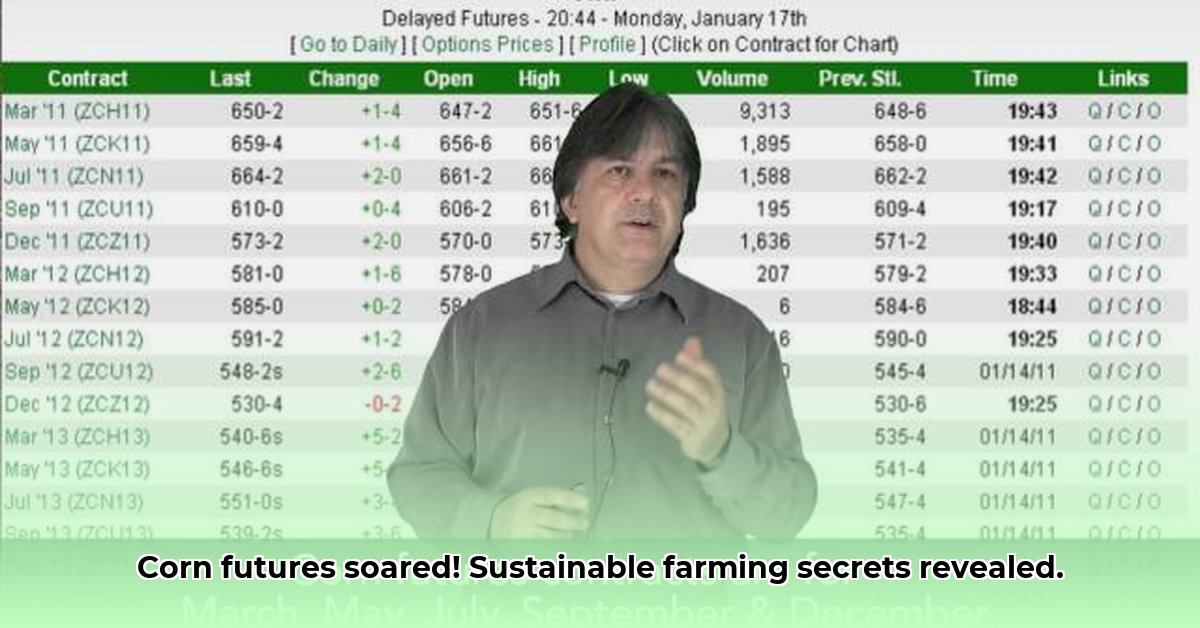
Dec 25 Corn Futures: A Rollercoaster Ride for Sustainable Farmers
The price of December 25th corn futures recently skyrocketed, reaching its highest point in over a year. This isn't just market fluctuation; it significantly impacts corn growers, particularly those dedicated to sustainable practices. Understanding these market dynamics is crucial for ensuring the long-term viability of sustainable farming. For more on ESG and sustainable investing, see this resource.
What's Fueling the Corn Price Spike?
Several factors contributed to this surge. Increased global demand, particularly from Mexico, significantly boosted exports compared to the previous year. While Brazil, a major corn producer, anticipates a successful harvest, market uncertainty persists. This uncertainty, combined with potential speculation by traders, drives the price upward. Further investigation is needed to fully determine the driving forces behind this price increase.
A Double-Edged Corn Cob: Opportunities and Challenges for Sustainable Agriculture
Higher corn prices present a double-edged sword for sustainable farmers. Increased profits could facilitate investments in eco-friendly practices, such as reduced fertilizer use and improved water management. However, the risk exists that these higher prices might incentivize unsustainable practices, like excessive chemical fertilizer application. This creates a critical juncture: Will this price increase propel truly sustainable methods or exacerbate environmental concerns?
Smart Strategies for Sustainable Corn Farmers: Actionable Steps
Here's how sustainable farmers can leverage this market shift:
Analyze the Economics of Sustainability: Carefully evaluate the long-term cost-effectiveness of environmentally friendly options. Compare the initial investment in biofertilizers, for example, with potential long-term savings and yield improvements.
Secure Pricing Through Contracts: Explore options to lock in favorable prices for your corn through forward contracts or other agreements, shielding against further price volatility.
Invest Strategically for Long-Term Gains: Prioritize long-term investments in drought-resistant seeds and precision agriculture technologies, which enhance efficiency and minimize environmental impact. These investments will improve your farm resilience.
Advocate for Supportive Policies: Actively support and engage in policy discussions advocating for government initiatives that incentivize and support sustainable farming practices.
Navigating the Risks: Challenges and Mitigation Strategies for Sustainable Corn Farmers
Sustainable corn farmers face several key risks that need proactive management:
| Risk Factor | Likelihood | Impact | Mitigation Strategies |
|---|---|---|---|
| Wild Price Swings | Very Likely | High | Diversify crops; utilize hedging strategies (futures contracts); secure long-term sales agreements |
| Climate Change Impacts | Very Likely | High | Implement drought-resistant crops; optimize water use; adopt climate-resilient farming techniques |
| Supply Chain Disruptions | Likely | Moderate | Secure diverse suppliers; cultivate strong buyer relationships; optimize storage and transportation |
| Pests & Diseases | Likely | Moderate | Employ Integrated Pest Management (IPM); use disease-resistant varieties; maintain farm hygiene |
| Regulatory Changes | Possible | Moderate | Stay updated on policy changes; participate in policy discussions; adapt operational strategies |
Government Regulation and Sustainable Corn Farming
The price surge might prompt increased regulatory scrutiny of farming practices. Proactive adaptation is key. Anticipate potential changes in regulations regarding fertilizer use, water management, and land use. Embrace best practices to ensure compliance and maintain sustainable operations.
The Future of Sustainable Corn Production
The fluctuating prices of Dec 25 corn futures highlight the opportunities and challenges within sustainable agriculture. The focus extends beyond short-term profit maximization to building a resilient and environmentally sound food system. The long-term success of sustainable corn farming hinges upon innovation, adaptation, and advocating for sound agricultural policies. Continued research is essential to fully understand the long-term impacts of market volatility on sustainable practices.
Mitigating Corn Price Volatility Risks for Sustainable Corn Farmers
The recent surge in December 25 corn futures underscores the vulnerability of sustainable corn farmers to price volatility. However, proactive risk management strategies can significantly mitigate these risks.
Understanding Market Volatility
Corn prices are inherently volatile due to factors including unpredictable weather, global supply chain disruptions, geopolitical instability, and fluctuating demand. Sustainable farmers must develop strategies to navigate this volatility whilst ensuring long-term financial stability and environmental sustainability.
Effective Hedging Strategies
Hedging using futures and options contracts is a proven method to manage price risk. These contracts allow farmers to lock in prices for future sales, protecting against price drops. However, hedging also limits potential upside if prices rise unexpectedly.
Implementing a Hedging Strategy:
- Evaluate Risk Tolerance: Determine your acceptable level of price fluctuation.
- Analyze Market Predictions: Utilize market forecasts and analyses to anticipate potential risks.
- Select Appropriate Hedging Tools: Choose the optimal combination of futures and options contracts aligning with your risk profile.
- Collaborate with a Broker: Consult an experienced commodities broker to navigate the complexities of futures markets and manage your hedging strategy effectively.
- Continuously Monitor: Regularly review and adjust your hedging positions as market conditions change.
Diversification: A Cornerstone of Risk Mitigation
Diversification across crops, value-added products, and markets is critical. This reduces dependence on a single commodity and market, thus mitigating overall risk.
Securing Future Sales with Long-Term Contracts
Negotiating long-term contracts with buyers provides predictable revenue streams and stabilizes cash flow. While sacrificing flexibility, these contracts offer security against price fluctuations.
Building Farm Resilience
Strengthening your farm's intrinsic resilience improves its capacity to withstand price shocks:
- Resource Efficiency: Optimize resource use (water, fertilizer) to maximize yields and reduce costs.
- Improved Storage: Invest in adequate storage facilities to allow for selling at optimal times.
- Financial Planning: Maintain sufficient financial reserves to buffer against temporary price downturns.
Leverage Technology and Information
Utilize available resources and technology to monitor market trends and improve decision-making. Access to real-time data and advanced agricultural software provides valuable insights and forecasting capabilities.
Government Support and Collaboration
Explore government support programs and collaborate with fellow farmers and agricultural organizations to access risk mitigation tools and shared knowledge.
Key Takeaways: A multi-faceted approach is crucial for sustainable corn farmers seeking to mitigate price volatility risks, combining hedging, diversification, long-term contracts, farm resilience improvements, information technology, and collaboration. Proactive risk management is paramount for the long-term sustainability of corn farming operations.